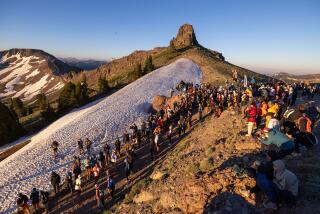Reno air race fans undaunted by last yearâs deadly crash
RENO â Anele Brooks is one of the many who came back.
A year after a vintage World War II fighter plane crashed at the annual air races here, killing 10 spectators and the pilot and injuring about 70 others, the San Luis Obispo-area woman sat in a box seat on the airport tarmac, not far from where the carnage occurred.
And even now, she refused to flinch at the sky.
She first came to this race in 1978, on the arm of her then-boyfriend. His friends told him back then that any date who could appreciate the beauty of those magnificent men in their flying machines was marriage material. The couple wed the following year â and since then have missed only a few of the annual races and aerobatic displays.
The other day, Brooks watched as the 2012 event at Reno-Stead Airport opened with a somber ceremony, a tearful remembrance by the Reno mayor and revamped safety rules ordered by the National Transportation Safety Board. While her eyes were on the here and now, Brooksâ thoughts were on the past.
Wearing a T-shirt bearing an image of a vintage 1932 Gee Bee racer plane, the 54-year-old real estate agent recalled what happened last Sept. 16 when the Galloping Ghost â a modified P-51 Mustang piloted by Jimmy Leeward â did the unthinkable and killed people who came to see it.
âIt was silent,â Brooks said. âI was several sections away and I saw the smoke. I was in shock....There were pieces of the aircraft hurtling down the runway. My son grabbed my arm and got me out of there.â
This yearâs show, which ends Sunday, exuded the collective sigh of an event thatâs relieved to be happening. Reno Air Racing Assn. President Mike Houghton acknowledged as much before the crowd, his voice echoing Thursday off the grandstands on a cloudless summer day.
âOver the past year, we wondered many times whether weâd have the opportunity to see you here today,â he said. âItâs been a long, long year.â
This year brought changes to the premier Reno event, an important annual boost to the regional economy and a show that locals were determined to keep.
After the crash, federal investigators faulted Leeward for playing âRussian rouletteâ by flying beyond his craftâs limits. The NTSB called for safety improvements that included the installation of 4-foot-tall concrete barriers in front of the grandstands and moving the races farther from the crowd. The race route was reconfigured to ease some of the tighter turns after investigators conducted a detailed review of all show operations.
The opening ceremonies were a muted affair that acknowledged the firefighters, paramedics and spectators who assisted the wounded and dying.
The U.S. flag few at half staff, and the green Huey helicopter that ferried many people to hospitals sat at center stage. After a moment of silence for the victims, Reno Mayor Bob Cashell sobbed as he related the bravery of one injured man he visited at a hospital. Counselors were on hand for anyone who needed to talk about the loss of life.
Chris Baum, president of the Reno-Sparks Convention and Visitors Authority, said the event was important not only to the region, but to the sport of air racing.
âThere are not many venues left,â he said. âFor decades before the tragedy this was a safe event, and it will be even safer now with new precautions in place. But people who come here know that with planes in the air, thereâs always the chance of a problem.â
During the show, the grounds carry the excitement of a NASCAR race with wings. There was a bit of Kentucky Derby pageantry mixed with a dash of a tacky state fair. People wore caps shaped like planes, their propellers spinning in the wind. Pointing their binoculars skyward, many snapped open beer cans at 11 a.m. One couple pranced the grounds with matching shirts that read, âYou canât drink all day if you donât start in the morning.â Another shirt read, âReno: Speed Limit 500 mph.â
All around, people poked their noses into the engines of display planes, ogling the specimens like bikers admiring their Harleys.
Michael Morgan, a commercial pilot from Virginia, sat in the shadow of a huge hangar and described why he loves air shows. âItâs the thrill of looking at the planes â new, old and experimental,â he said. âItâs smelling the fuel. A lot of people here are pilots and can relate to just how difficult these stunts are.â
One event after another underscored the pilotsâ pinpoint accuracy. One propeller plane landed on the tarmac and came to rest against the outstretched hand of the announcer, who broadcast to the crowd just how safe he felt. The same plane later landed on the back of a moving truck.
While the crowd did not fill the viewing stands, announcers insisted that by the weekend fans would be âelbow to elbow.â The show typically draws about 200,000 spectators over four days. Race spokeswoman Valerie Miller-Moore said organizers wouldnât calculate attendance figures until after the end of the event. She said that Thursdayâs and Fridayâs crowds âwere on par with last year.â
But on that first day, the announcers seemed grateful that anyone had come at all.
âHow many people came back after last year?â asked the announcer as hundreds of hands flew up.
âThank you, thank you, thank you,â came the reply.
More to Read
Sign up for Essential California
The most important California stories and recommendations in your inbox every morning.
You may occasionally receive promotional content from the Los Angeles Times.











